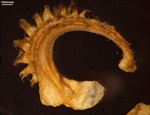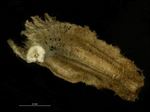Taxonomy
Calendula officinalis L., Sp. Pl. 2:921. 1753
Common synonyms
Calendula arvensis subsp. hydruntina (Fiori) Lanza; Calendula aurantiaca Kotschy; Calendula aurantiaca Kotschy ex Boiss.; Calendula eriocarpa DC.; Calendula hydruntina (Fiori) Lanza; Calendula officinalis var. officinalis; Calendula officinalis var. prolifera; Calendula prolifera Hort. ex Steud.; Calendula santamariae Font Quer; Calendula sinuata var. aurantiaca (Klotzsch ex Boiss.) Boiss.; Caltha officinalis (L.) MoenchCommon name
Pot / common / Scotch marigold, ruddles
Description
Propagule or dispersal unit is the fruit. Fertile part 5-25 mm long, 1-5 mm wide, in side view widest in lower part (ovoid), conspicuously curved, the upper (apical) end narrowing, in cross-section round (terete) or flattened, wings absent or wings present, 0.1-3 mm wide, fruit surface light brown or straw, smooth (except at cellular level) or wrinkled or with round protrusions or bumps, with no hairs (glabrous), simple straight hairs, woolly / crispate hairs or glands or glandular hairs, thickened margin absent, longitudinal ribs present, 2-8, their surfaces toothed, serrated or scale-like or bumpy or notched, with simple straight hairs, woolly / crispy hairs or papillae (small protuberances).
Pappus absent.
Ecology
Short-lived perennial herb, fruits large, epappose and thorny to warty, usually dispersed by humans. Mostly warm-temperate to Mediterranean areas. Generally found in gardens and as garden escapees
Native range
Unclear, presumed to be southern Europe. Cultigen.
Introduced range
Most of North America, Colombia, Ecuador, Peru, Brazil, Chile, Argentina, all of Europe beyond the native range, warm-temperate Asia incl. southern China, south-eastern Australia, New Zealand













